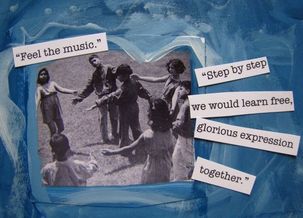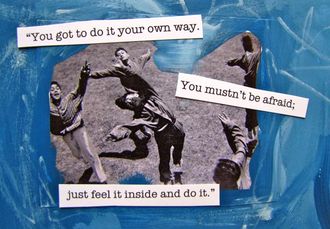The Teaching Method of Natalie Robinson Cole
Free Rhythmic Dancing

Natalie Robinson Cole's motive for including dance in her curriculum, is to free the child, have him get in touch with his emotions and build confidence.
Robinson Cole shares an experience from her past in which dancing resulted in embarrassment. She uses this example to convey an important point: The teacher must put aside old ideas and put faith in her students to use their innate way of dancing, which is expression in it's purest form. She offers guidelines for encouraging the dancer within each child. Moving from the "body center" is first and foremost (p. 71). "Bouncing in a circle" get children to lose inhibition and begin to feel the music. Then she has them rock back on forth on their feet, from heel to toe. All of these simple movements get the children to connect to the feeling of the music. As always she tells the students to "do it their own way".
Some of the children, especially boys may scoff at the idea of dancing at first. Instead of giving up on such children, Robinson Cole tells us to never say a negative word. Instead she uses encouragement and praise instead of pointing out mistakes. As with every artistic expression the children take on in her class, she finds something positive in their work and makes a point to mention it, thereby lifting the child up. Some of them might even descend into "silly business" (p. 86) as Robinson Cole likes to call it. She feels this a necessary part of the process and an important part of "letting go" for the child as well as the teacher.
Robinson Cole shares an experience from her past in which dancing resulted in embarrassment. She uses this example to convey an important point: The teacher must put aside old ideas and put faith in her students to use their innate way of dancing, which is expression in it's purest form. She offers guidelines for encouraging the dancer within each child. Moving from the "body center" is first and foremost (p. 71). "Bouncing in a circle" get children to lose inhibition and begin to feel the music. Then she has them rock back on forth on their feet, from heel to toe. All of these simple movements get the children to connect to the feeling of the music. As always she tells the students to "do it their own way".
Some of the children, especially boys may scoff at the idea of dancing at first. Instead of giving up on such children, Robinson Cole tells us to never say a negative word. Instead she uses encouragement and praise instead of pointing out mistakes. As with every artistic expression the children take on in her class, she finds something positive in their work and makes a point to mention it, thereby lifting the child up. Some of them might even descend into "silly business" (p. 86) as Robinson Cole likes to call it. She feels this a necessary part of the process and an important part of "letting go" for the child as well as the teacher.
Feeling the Music

Starting with simple movements and then letting the children go free, they become more spontaneous but still feel the music and move accordingly. Robinson Cole uses words to connect visual ideas such as tree limbs for arms to get children thinking about ways to move expressively. Whirling and twirling and encouraged as children naturally love to move in that manner.
"Praising--praising--praising, we grow."
"Praising--praising--praising, we grow."

Many children love the big muscle movement of jumping..especially the boys. Robinson Cole encourages them to jump and leap when their body feels the urge, during appropriate intervals of the music.
Robinson Cole also teaches children to listen to the and feel the tone of the music (p. 96). When children are in touch with the tone of the music, they use their expressive dance to match the mood.
Robinson Cole also teaches children to listen to the and feel the tone of the music (p. 96). When children are in touch with the tone of the music, they use their expressive dance to match the mood.
Trying out Robinson Cole's Methods in the 21st Century
I thought it would be interesting to see if I could get my daughter, Maddy and her friend to try free rhythmic dancing. It took a while for the them to loosen up (and yes, there was a bit of "silly business") but I think this was actually more successful than the painting experiment. I used actual music suggestions from The Arts in the Classroom. First, I had them dance to Ketelby's "In a Monastary Garden":
Next, came the "silly business". Since Robinson Cole felt the silly business was a necessary part of the process, I let it go and decided to include it here. Actually, there was more silly business than I'm posting here, but you get the idea:
Finally, I had them dance to Hungarian Rhapsody No. 2 by Franz Liszt. The movement became a bit more dynamic and free at this point:
